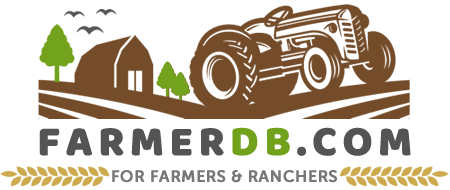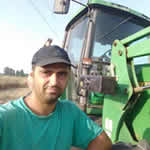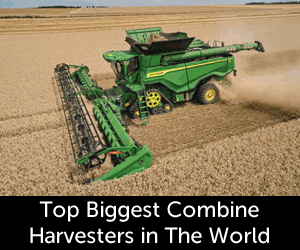The Mulefoot hog is a rare heritage pig breed and a domestic one with roots tracing back to early Spanish hogs.
Even though it has Spanish origins, the breed developed in the United States and was later bred in the Mississippi River Valley, where it became valued for its hardiness.
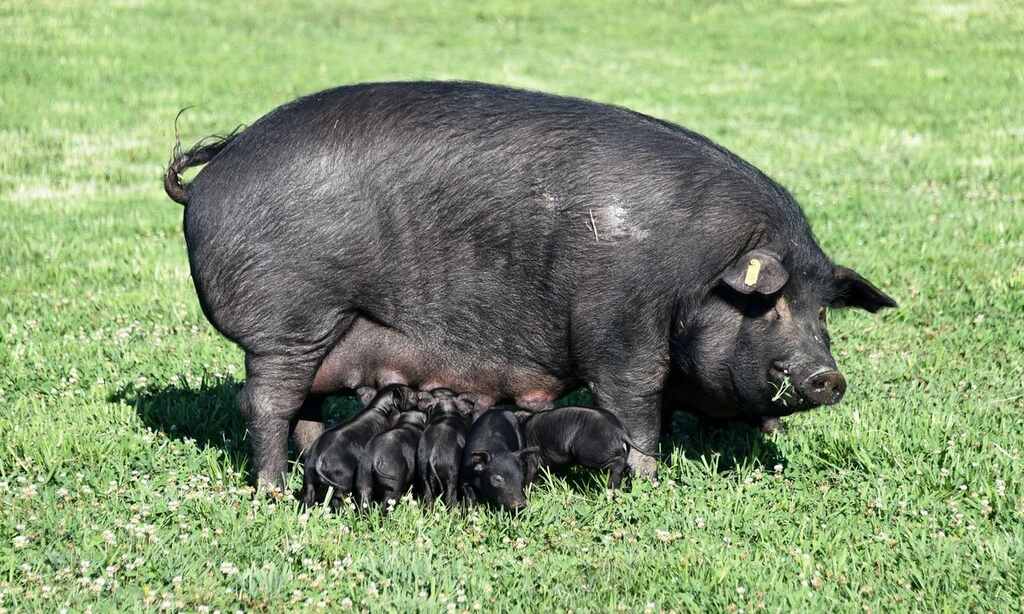
Once common on small farms, Mulefoot hogs have become rare, and today, they are listed as “Critical” by the Livestock Conservancy.
There are very few left in the world, putting the breed at risk of disappearing.
Efforts are being made to preserve them through dedicated breeders and conservation programs.
Contents
Characteristics
Color
Mulefoot hogs have a solid black coat.
In rare cases, they may have small white markings on the belly or feet.
Skin, Coat
The skin of this pig breed is thick, smooth, and dark-colored, mostly black or bluish-black. It is covered with a coarse black coat that is dense but short.
Head
The head is medium to large, with a broad forehead and a profile that is either straight or slightly dished. The head shape varies between individuals, with some having a straight profile while others exhibit a very slight dish. Straight or slightly dished, it is definitely not concave like in some other pig breeds.
The snout is well-developed, not too long, and slightly upturned, while the muzzle is strong, featuring a dark, moist nose with large, well-defined nostrils.
Eyes
The eyes are dark brown or black, small, and set wide apart. The area around the eyes is free of excessive wrinkles.
Ears
Mulefoot hogs have medium ears that are a bit rounded at the tips. Some stand upright, while others flop forward slightly. They have a rough coat of short hair, and some pigs may have longer tufts along the edges.
Shoulders
The shoulders are wide, well-shaped, and align evenly with the back and neck, maintaining good thickness throughout.
Chest
The chest is large, wide, deep, and full, with good width and fullness extending behind the shoulders.
Back
The back is broad, long, and well-shaped, without being too arched or too flat. This sturdy frame also supports a deep chest.
Sides
The sides stretch from the shoulder to the ham, reaching down to the belly line. They are deep, full, and even.
Legs
One of the most distinctive features of this breed is its hooves. Instead of the usual split hooves seen in pigs, it has a single, solid hoof like a mule. Its legs are sturdy and well-built, with slightly shorter front legs
Tail
The tail is of medium length, thick at the base, and tapers well toward the end.
Size
These pigs are medium-sized, standing between 3 and 3.5 feet (91 to 107 cm) tall and measuring around 4 to 5 feet (1.2 to 1.5 meters) in length.
Lifespan
These pigs can live for 10 to 12 years if they are well cared for and fed a good diet that fulfills all their nutritional needs. They live long enough to match the average lifespan of pigs.
Growth Rate
How fast do they grow?
These pigs have a moderate growth rate.
They grow steadily and at a reliable pace, but they still cannot match the growth rate of modern commercial breeds like Landrace or Yorkshire.
Weight
A fully grown Mulefoot hog can weigh anywhere from 400 to 600 lbs (180 to 270 kg). Males are usually closer to 550 lbs (250 kg), and females around 450 lbs (200 kg).
Even though they have a lower growth rate, their final size is not that far from that of modern commercial pigs.
Slaughtered Time
These pigs can be slaughtered starting at 8 months of age.
At this age, they can weigh around 285 to 300 lbs (129 to 136 kg). The carcass weight for this breed after slaughter is around 60% of the live weight. But, the net meat value remaining after cutting it into the right cuts is even lower, around 47%.
| Category | Weight |
|---|---|
| Live Weight | 285 to 300 lbs (129 to 136 kg) |
| Carcass Weight (60%) | 171 to 180 lbs (78 to 82 kg) |
| Net Weight After Cutting (47%) | 80.4 to 84.6 lbs (36.7 to 38.5 kg) |
It is also good to wait longer, even until 12 months, if you want a higher meat yield from these pigs.
Temperament
These pigs have a good disposition with a calm and easy-to-manage temperament.
Both males and females are gentle and can become familiar with their caregivers, even recognizing them. Sometimes, they forget how big they are and seek attention or enjoy being petted.
Even though they are sweet, it’s important to remember that they are still animals and should be approached with care while also respecting their space.
First-time mothers can be protective and may become aggressive if you try to get too close to their newborns, so it’s best to handle them with caution and care.
Meat
One thing that farmers who have raised this pig breed say is that the meat of these pigs is worth the wait, as it tastes completely different from the meat of modern commercial pigs.
Their meat is mostly lean, as they are efficient at converting feed into muscle rather than fat. But they also have a moderate amount of intramuscular fat, which makes the meat juicy and flavorful.
The rich flavor and slightly sweet taste come not only from their diet but also from their more balanced growth rate.
Raising
Feeding
You can raise these pigs by feeding them forages and pasture, vegetables, protein sources, and grains.
The easiest way to feed them is to base their diet on pasture-based feeding if you have a pasture. In this case, you can just let these pigs roam freely, and they will feed themselves on fresh grasses, grubs, and other natural forage. They have a strong grazing and rooting instinct and will actively search for food while also burning energy.
You can plant different grasses and weeds on your pasture, such as clover, alfalfa, and other leafy greens. You can also offer them various crops if you have them, like turnips, daikon radishes, sweet potatoes, or beets.
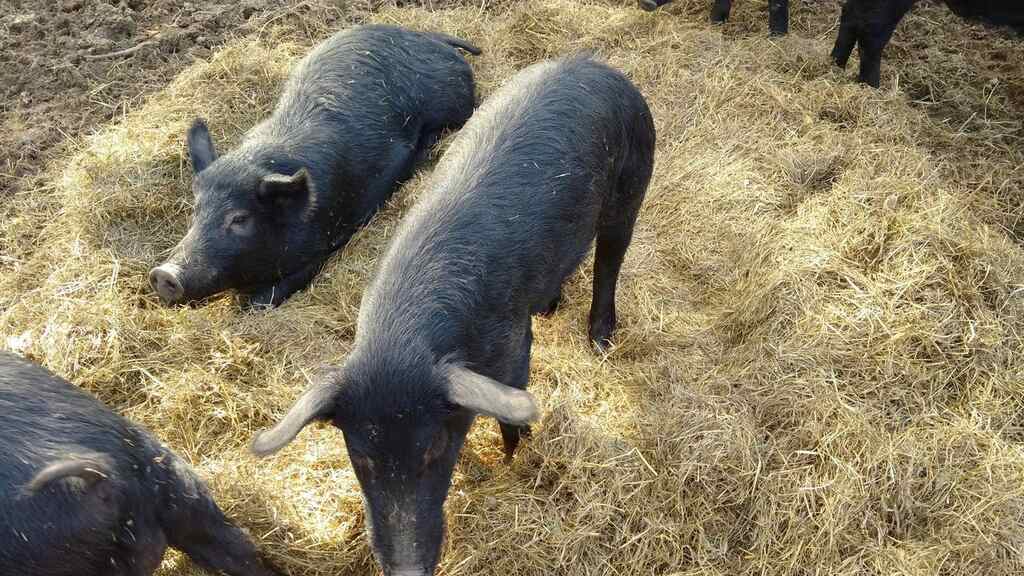
They also love acorns, walnuts, and hickory nuts, so if you have these on your farm, just let them enjoy them.
If you do not have a large pasture and need to supplement their feed, you can add grains and protein to their diet. Corn or soybean meal is a good protein source, but barley or oats can also help with digestion.
Other foods you can include in their diet are kitchen scraps (without salt or sugar), some fruits like apples, pears, and berries (in moderation), and vegetables like pumpkin, squash, carrots, leafy greens, and cooked potatoes.
Do not forget to provide them with a freshwater source that they can access at all times.
Environment
Being a heritage breed, the right environment for these pigs is pasture-based or free-range. These environments allow them to exercise their natural behaviors, such as rooting, foraging, and grazing.
If you do not have a full pasture, you can raise them in a semi-free-range system with shelter access, but you must provide enough space and ensure they have large paddocks with rotating grazing areas.
You should avoid raising them indoors or in pen-based systems, as this can cause stress and health issues.
Climate
The right climate for them is temperate, with mild winters and warm summers, but they also grow well in warmer climates with higher temperatures or humidity.
If you live in a colder climate, that doesn’t mean you can’t raise them, but you will need to provide the right conditions to keep them comfortable. They can tolerate some colder temperatures, but not freezing ones, as their coat is not woolly like other breeds, such as Mangalica pigs.
Remember that if you raise them in colder temperatures, you may need to feed them more to help them maintain their body weight and warmth.
Shelter
These pigs need shelter, a wallow, and an electric fence.
They need shelter to protect them from extreme weather conditions such as cold, heat, rain, wind, and snow. Inside the shelter, especially in colder climates, you have to place straw or hay bedding to keep them warm and dry to prevent illness.
The wallow is essential in hot weather, as they use it to regulate their body temperature and protect themselves from the sun.
Lastly, an electric fence is a must to keep them within their territory, as they are curious and always looking for ways to escape.
How many pigs per acre?
On high-quality pasture, you can raise between 5 to 7 Mulefoot pigs per acre.
This number can vary depending on your farm management practices and how you choose to feed the pigs.
For example, on high-quality pasture, if you also practice rotational grazing, you can increase the number to 10 pigs per acre.
If you provide additional feed alongside pasture, you may be able to raise more pigs per acre.
On moderate pasture with some feed supplementation, you can raise 3 to 5 pigs per acre, while on very poor pasture, you should not exceed 3 pigs per acre.
If you are unsure, you can always monitor the animals and check if their weight is healthy. If they look thinner, it may mean that the stocking rate needs adjustment. You should also observe the pasture regularly for signs of overgrazing.
Breeding
Mulefoot females reach puberty at 4 to 7 months, while males reach puberty at 8 months.
This pig breed has good fertility as long as they maintain a healthy weight. Overweight pigs can have fertility issues, so it is important to monitor their feed intake.
When choosing to breed them, you should look for a boar with the right characteristics, as its traits and health matter more than those of the sows.
When breeding a boar for the first time, you should introduce him to sows that are not significantly larger than him and are not aggressive. If the boar feels intimidated, he may refuse to mate again. Therefore, it’s best to choose a calm and gentle sow for his first mating.
Sows have an estrous cycle of approximately 21 days, with a heat duration of 2 to 3 days and ovulation taking place within 12 to 36 hours. Once you observe that a sow is in heat, you should introduce the boar.
Some say it’s better to mate them early in the morning, as the boar tends to be more energetic before eating. It is recommended to introduce the sow to the boar rather than moving the boar to a different location, to avoid stressing him.
The breeding lifespan of a boar is typically 3–4 years, after which they often become too large for younger sows and may develop leg issues.
The average gestation period for females is around 115 days. Their litter size ranges from 5 to 8 piglets per litter. They are good mothers and take good care of their newborns, sometimes becoming overprotective.
Health Issues
Even though they are disease-resistant, these pigs can suffer from obesity and joint problems, internal and external parasites, and heat stress or sunburn if not properly cared for.
Why should you raise it?
Mulefoot hogs can do well in a homestead setup and are worth raising, even though finding them can be challenging. They offer many advantages, including being easy to manage, adaptable to different feeding methods, and requiring low maintenance, all of which align well with the needs of homesteads and small farms.
One of their biggest advantages is that you can feed them in various ways, from foraging to grain-based diets. They are also calm and easy to handle, which makes caring for them less stressful.
In the end, the reward is not only their high-quality, flavorful meat for you and your family but also the opportunity to contribute to the preservation of a rare breed that is close to extinction.
Advantages
- Low maintenance
- Good temperament
- Adaptable to different feeding methods
- Good foragers
- High-quality meat
- Strong maternal instincts
- Great fertility
- Hardiness
- Good litter size
Disadvantages
- Difficult to find
- Moderate growth rate
- Sensitive to extreme cold
- Not ideal for industrial farming
References
- American Mulefoot Breeders Association, Inc. link
Do you have any experience with the topic discussed here?
Would you like to improve the information shared and contribute your practical knowledge on the subject?
Your real-world experience as a farmer or rancher could greatly benefit other members, and the community would deeply appreciate your contribution.
